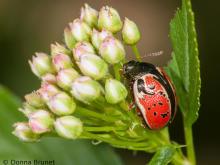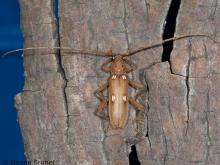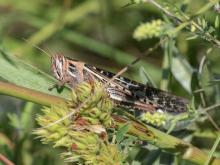Land Invertebrates
Media

Species Types
Scientific Name
Neoharmonia venusta
Description
The V-marked lady beetle, one of our many native lady beetles, is very attractive. The pattern and coloration can vary greatly among individuals, but most in this species have a V on the back.
Media

Species Types
Scientific Name
Calligrapha spiraea
Description
The ninebark calligraphy beetle is one of nearly 40 North American calligraphy beetles, named for the scrawly markings on their backs. Most calligraphy beetles require particular host plants.
Media

Species Types
Scientific Name
Acanthoderes quadrigibba
Description
The four-humped flat-faced longhorn has no true common name, but its markings are distinctive. It plays an important role in breaking down rotten wood and enriching soils.
Media

Species Types
Scientific Name
Eburia quadrigeminata
Description
The ivory-marked beetle is a longhorned beetle whose larvae bore deep into the heartwood of a variety of deciduous trees, including oak, hickory, maple, cherry, ash, elm, and more. It can live for 40 years.
Media

Species Types
Scientific Name
Acanthepeira stellata
Description
Mature female starbellied orbweavers spin wheel-shaped webs in prairies and other open, sunny habitats. The abdomen is decorated with a crown of spines and usually has a star pattern on the back.
Media

Species Types
Scientific Name
Schistocerca spp.
Description
About six species of bird grasshoppers occur in Missouri. Most are attractively marked, large insects that gracefully fly from danger, almost like birds.
Media

Species Types
Scientific Name
Schistocerca americana
Description
The American bird grasshopper is a large grasshopper with ornate markings. It is a good flier that floats upward into trees. Note the pale stripe running down the back.
Media

Species Types
Scientific Name
About 2,000 species in North America north of Mexico
Description
Plant bugs, or mirids, are a huge family of true bugs. They are often overlooked — except by gardeners and farmers. Most mirids eat plants, and some are agricultural pests. As a group, they’re an important food source for birds and other insectivores.
Media

Species Types
Scientific Name
Scudderia furcata
Description
The fork-tailed bush katydid reaches about 1¾ inches long. It is usually leafy green and is most common in bushes, thickets, and other shrubby areas. It is most active after dusk. The call is a simple "tsip!" given every few seconds.
Media

Species Types
Scientific Name
Pachypsylla spp.
Description
Hackberry psyllids are a genus of tiny, planthopper-like bugs. As larvae, they develop within the leaves, twigs, buds, or bark of hackberry trees. The trees form warty galls in response to their presence. In the fall, tiny adult hackberry psyllids cling to window screens.
See Also



Media

Species Types
Scientific Name
Cisseps fulvicollis
Description
The yellow-collared scape moth is more often “orange-collared.” And whether you think it looks more like a firefly or a wasp, it’s still a moth!
Media

Species Types
Scientific Name
Nearly 150 species in North America north of Mexico
Description
Slim, delicate plume moths are instantly recognizable by their T-shaped silhouette, long legs, and muted shades of tan and brown. It can be hard to separate the various species.
Media

Species Types
Scientific Name
Pyrrharctia isabella
Description
Not many people know the adult Isabella tiger moth when they see one, but we’re all acquainted with its caterpillar, the woolly worm, or woolly bear.
About Land Invertebrates in Missouri
Invertebrates are animals without backbones, including earthworms, slugs, snails, and arthropods. Arthropods—invertebrates with “jointed legs” — are a group of invertebrates that includes crayfish, shrimp, millipedes, centipedes, mites, spiders, and insects. There may be as many as 10 million species of insects alive on earth today, and they probably constitute more than 90 percent all animal species.





















